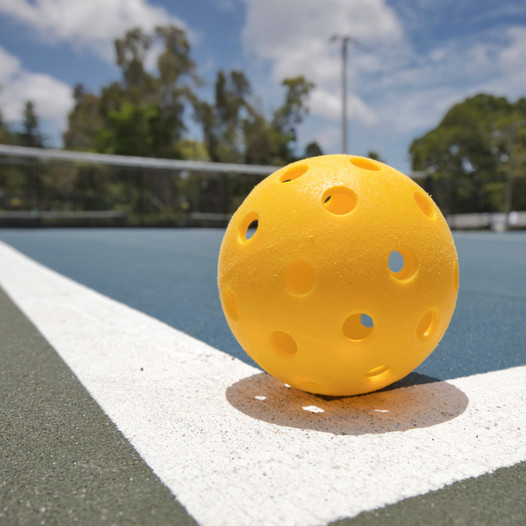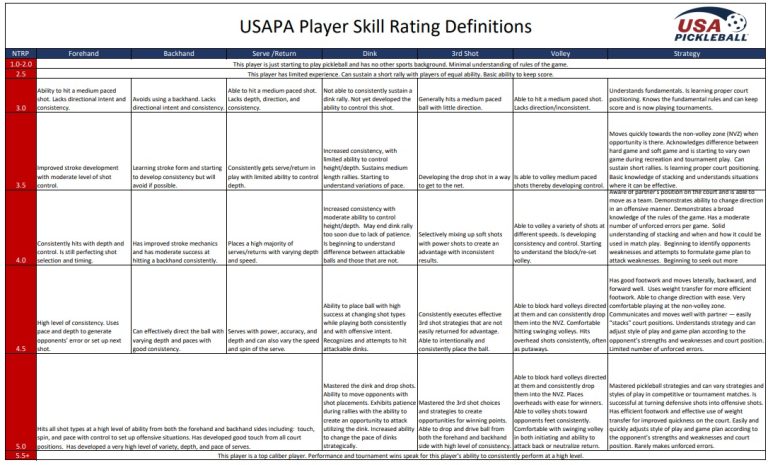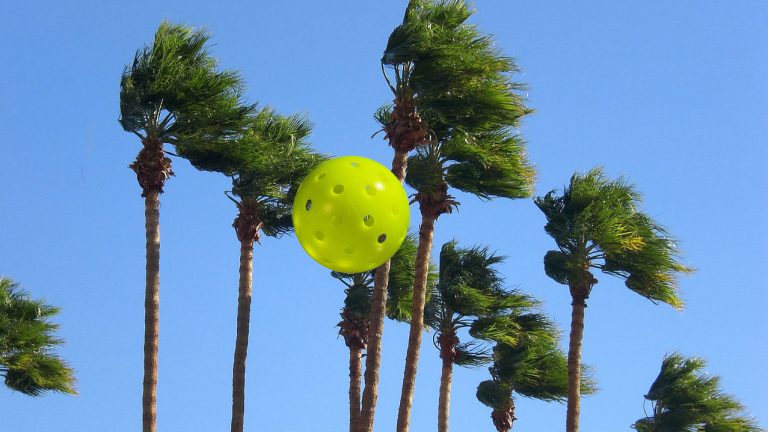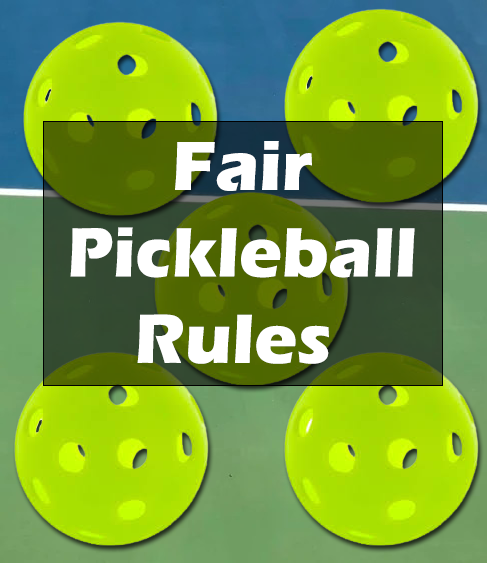Rules to Pickleball: Guide
Your Ultimate Guide to Playing and Scoring
Looking to learn pickleball or need a rules of pickleball refresher? You’ve found the right guide! We’ll explain all the rules you need to understand pickleball, including serving, scoring, and net height.
Pickleball Court and Set-Up
Let’s start with the court and set-up. The dimensions of a pickleball court match those of a badminton court: 20 feet by 44 feet. The net measures 36 inches high at the sidelines and 34 inches high at the center. Doubles matches, with two players on each team, are more common in pickleball, but you can also play singles. Each player stands to one side of the centerline.
In pickleball, players use two types of shots: groundstrokes and volleys. Players hit groundstrokes off the bounce, often from the baseline. Volleys, on the other hand, are shots hit out of the air from a position closer to the net.
Each side of the court has a 7-foot area called the Non-Volley Zone, or “Kitchen.” No player may hit a volley from this area. Even a toe cannot touch the kitchen line during a volley.
Pickleball Serving Rules
A player on the right side of the court starts the game and each point with a serve, facing their opponents. The server must serve diagonally to an opponent, into the right or left service area. The serve must bypass the “Kitchen” (including the line) to count.
Serving Height
A player must hit a pickleball serve with an underhand stroke, striking the ball below the waist. When you serve, your arm should move in an upward arc. You have the option to hit the ball out of the air (as most players do), or you can drop the ball on the ground and then hit it.
Unlike a tennis serve, the goal of a pickleball serve isn’t to win the point by serving overhand aggressively, but rather to initiate play.
Pickleball Scoring Rules
After the serve, gameplay continues until one team commits a “fault.” A fault concludes a point. There are 3 common types of faults in pickleball::
- The serve doesn’t clear the kitchen (including the line).
- A player hits a shot out of bounds – landing behind the baseline or outside the sideline.
- A player hits a shot into the net.
Unlike in tennis, pickleball does not offer a second serve chance. When a fault occurs, the ball goes to the other side to serve. Each player on the serving team has an opportunity to serve and score points for their team until they commit a fault.
Pickleball Net Height
Pickleball’s net is lower than a tennis net, with a height of 36 inches at the ends, and 34 inches at the center. This lower height allows for longer rallies and volleys, quickening the game’s pace and making it more exciting.
Pickleball 101 Rules
Here are 5 basic rules to get you started:
- Each serve must land in the opposite diagonal court.
- Players must serve underhand with the paddle contact below the waist.
- There is only one serve attempt, unless it touches the net and lands in the correct service court (known as a “let”).
- Players cannot volley the ball (hit it in the air without it bouncing) in the Non-Volley Zone (or “Kitchen”).
- Players must let the ball bounce once on each side of the court before volleys are allowed.
Pickleball Equipment
Before you can start playing pickleball, you’ll need to gather the right equipment. This includes:
Paddles
Pickleball paddles are typically made from lightweight composite materials like graphite or aluminum. They are larger than ping pong paddles but smaller than tennis rackets, making them perfect for the unique demands of pickleball.
Balls
Pickleball balls are similar to wiffle balls, but are designed specifically for the sport. They have a unique pattern of holes that allows them to fly straight and true.
Footwear and Clothing
Comfortable athletic shoes are a must for pickleball. Choose shoes that provide good support and traction. As for clothing, wear something that allows for easy movement. Athletic shorts, t-shirts, or tank tops are all good choices.
Pickleball Strategy and Techniques
Mastering pickleball requires more than just the right equipment. Here are some basic strategies and techniques to help you improve your game:
Positioning
Good positioning is key in pickleball. Try to stay near the center of your side of the court to maximize your ability to reach any shot.
Shot Selection
Choose your shots wisely. A well-placed shot can be more effective than a powerful one. Aim for your opponent’s feet or the corners of the court to keep them off balance.
Communication in Doubles Play
When playing doubles, communication with your partner is crucial. Make sure to call out who will take each shot to avoid confusion.
Health Benefits of Pickleball
Pickleball is not only fun, but it’s also a great way to stay healthy. Playing pickleball can help improve your cardiovascular fitness, enhance your balance and agility, and even boost your mood.
Pickleball Etiquette
Like any sport, pickleball has its own set of unwritten rules or etiquette. Here are a few key points to keep in mind:
- Always respect the lines and call your shots honestly.
- Be mindful of your noise level, especially in residential areas.
- Never walk behind a court while a point is still in play.
How to Get Started with Pickleball
Ready to start playing pickleball? Here’s how to get started:
- Find a local court or league. Many parks and recreation departments now offer pickleball facilities.
- Invest in the right equipment. As mentioned above, you’ll need a paddle, ball, and appropriate athletic wear.
- Learn the rules. You can find the official rules of pickleball on the USA Pickleball Association‘s website.
Frequently Asked Questions
Q: What is pickleball?
A: Pickleball is a paddleball sport that combines elements of badminton, table tennis, and tennis. It’s played on a badminton-sized court with a perforated plastic ball and paddle. It’s a game that’s easy to learn, but can develop into a quick, fast-paced, and competitive game for experienced players.
Q: What are the basic rules of pickleball?
A: The basic rules involve serving underhand from behind the baseline, hitting the ball into the opposite service court, and avoiding volleys in the Non-Volley Zone. There’s also the “double bounce” rule which requires each team to play their first shot off the bounce.
Q: What is the Non-Volley Zone or Kitchen in pickleball?
A: The Non-Volley Zone, also known as the “Kitchen,” is a seven-foot area on both sides of the net. No volley shots can be played from the kitchen. If the player or his paddle touches the Kitchen on a volley, it results in a fault.
Q: What is the net height in pickleball?
A: The net height in pickleball is 36 inches at the sidelines and 34 inches in the center.
Q: How do you serve in pickleball?
A: In pickleball, the serve is made underhand from behind the baseline, striking the ball below the waist. The serve must land in the service court diagonal to the server.
Q: How do you score points in pickleball?
A: Points are scored by the serving team when the opposing team commits a fault. Faults can occur from serves not clearing the kitchen, shots out of bounds, or shots hit into the net.
Learning the rules of pickleball is essential to playing the game correctly and safely. By following the rules, players can have a fun and exciting experience while improving their skills and strategies. Whether you’re a beginner or an experienced player, understanding the basics of how to play, serve, and score can help you enjoy the game more fully.







